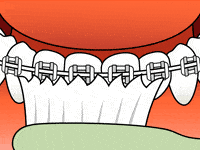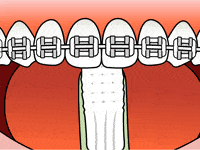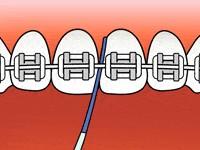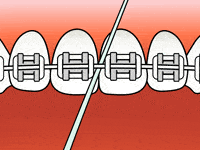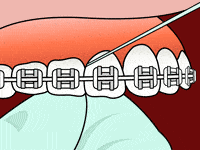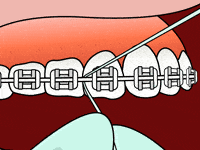Now that you have your braces, how do you take care of them? It’s important for you to know how to properly take care of your braces throughout your entire orthodontic treatment.
Eating with Braces
Don’t worry! You’ll be eating popcorn and snacking on potato chips again in no time! However, before you can start enjoying some of the treats you love, you will need to take special care to avoid any foods that could damage your new appliances.
Foods to Avoid with Braces:
- Chewy foods – gum, taffy, licorice
- Crunchy foods – popcorn, hard chips, ice
- Sticky foods – caramel candies, chewing gum
- Hard foods – nuts, hard candies
- Foods that require biting into – corn on the cob, apples, carrots, bagels
Foods You Can Eat with Braces:
- Dairy – soft cheese, pudding, milk-based drinks
- Breads – soft tortillas, pancakes, muffins w/o nuts
- Grains – pasta, soft-cooked rice
- Meats/poultry – soft-cooked chicken, meatballs, lunch meats
- Seafood – tuna, salmon, crab cakes
- Vegetables – mashed potatoes, steamed spinach, beans
- Fruits – applesauce, bananas, fruit juice
- Treats – ice cream w/o nuts, milkshakes, Jell-O, soft cake
Soreness Caused by Braces and Appliances
When you first get your braces, you may notice that your teeth and mouth feel a little tender or sore. This is perfectly normal for patients who have just had their braces put on or adjusted, and we promise your mouth will not be sore forever! We recommend dissolving one teaspoon of salt in eight ounces of lukewarm water to relieve mouth sores or ulcers. Swish and gargle this solution in your mouth for just a couple of minutes (do not swallow the saltwater).
If the pain is more severe and does not go away after rinsing, you can also take a pain reliever. It is not uncommon for your lips, cheeks, and tongue to become irritated for one to two weeks as they toughen up and adjust to the braces. Soft wax that came in your start-up kit can be helpful; pinch a small amount off and roll into a tight pea-sized ball, then press onto the brace or wire that is making your lip or cheek uncomfortable. If you need more wax, please let us know!
Loose Teeth
If your teeth begin feeling a little loose, don’t worry; this is normal! Your braces must first loosen your teeth in order to move them into the correct position. Once your teeth have been repositioned, they will firm up and stabilize in their new position.
Loose Wires and Bands
The wires and bands on your braces may come loose. If this happens, please contact us as soon as possible so that we can check and repair your braces. If any piece of your appliance comes off, be sure to save it and bring it to the office with you.
You can temporarily fix a loose wire by using the back of a spoon or the eraser end of a pencil to carefully and gently push the wire back into place. Tweezers may also be helpful to direct the end of a wire back into the tube on a back molar band. If the loose wire is causing irritation to your lips or cheeks, put wax or a wet cotton ball over the broken wire to relieve the pain.
Take Care of Your Appliances
Damaged appliances can increase the length of your treatment process, so be sure to take care of all your appliances. Your teeth and jaws can only move into their correct positions if you consistently wear the rubber bands, headgear, retainer, or other appliances prescribed by Dr. Romani.
Brushing Your Teeth with Braces
It is essential to brush and floss after every meal to keep your teeth and gums healthy throughout your orthodontic treatment. If you need help choosing the right toothbrush, toothpaste, or dental floss, please ask us to help you choose the right products for your teeth and your appliances.
Brushing Instructions
Brushing: Step 1
Place your toothbrush at a 45-degree angle to your gum.
Brushing: Step 2
Brush gently in a circular motion.
Brushing: Step 3
Brush the outer, inner, and chewing surfaces of each tooth.
Brushing: Step 4
Use the tip of your brush for the inner surface of your front teeth.
Flossing Instructions
Flossing: Step 1
Wind about 18 inches of floss around your fingers as shown. Most of it should be wrapped around one finger, and as the floss is used, the other finger takes it up.
Flossing: Step 2
Use your thumbs and forefingers to guide about one inch of floss between your teeth.
Flossing: Step 3
Holding the floss tightly, gently saw the floss between your teeth. Then curve the floss into a C-shape against one tooth and gently slide it beneath your gums.
Flossing: Step 4
Slide the floss up and down, repeating for each tooth.
Playing Sports with Braces
Game, Set, Match – we have great news for athletes! You can still play sports even while undergoing orthodontic treatment! If you do play sports, it is recommended that you wear a mouthguard to protect your teeth and appliances. Let Dr. Romani know if you need help finding the right mouthguard for the best protection.
In case of a sports emergency, be sure to immediately check your mouth and your appliance for any damage that may have occurred. If you notice any loose teeth, or if your appliance has been damaged, please contact our office right away. You can temporarily relieve the discomfort with wax or by rinsing your mouth with warm saltwater.





